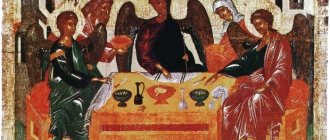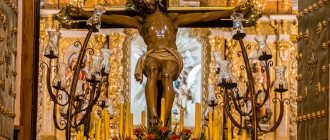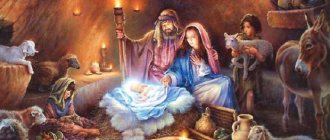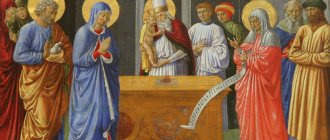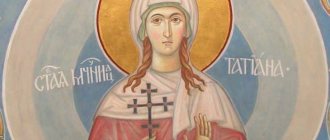How Christmas is celebrated in modern Russia
Christmas continues the series of New Year holidays, so the streets of cities and villages are already decorated with illumination and garlands. Large live or artificial Christmas trees with New Year's paraphernalia are installed in the squares in the center.
Every family prepares for the New Year and Christmas: they buy and decorate a Christmas tree (why they decorate a Christmas tree, I wrote about this here), and decorate the house. Household members are sure to plan gifts and congratulations for each other. Souvenirs, gifts and decorations made with your own hands are especially valued. Children await this event with the greatest trepidation, because they believe in miracles and fairy tales.
On the eve of the holiday itself, Orthodox believers go to services in Temples, where Great Compline and All-Night Vigil take place. Christmas services from January 6 to 7 from the Cathedral of Christ the Savior in Moscow are usually broadcast on federal channels. The solemn service is headed by the Patriarch of All Rus' himself.
All-Night Vigil
The long Nativity Fast ends with the celebration of Christmas. Housewives pay special attention to preparing traditional dishes. On January 7, Christians are allowed to eat a large meal without restrictions. Each housewife is free to decide for herself what treats to put on the Christmas table. Usually they prepare pies, salads, jellied meat, bake goose or chicken with apples and treat family and friends with all kinds of desserts.
Why do the dates of Catholic and Orthodox Christmas not coincide?
Depending on which calendar believers adhere to, Christmas is celebrated on the night of December 24-25 (Gregorian calendar) or January 6-7 (Julian calendar). In most countries of Western Europe, where Catholics and Protestants live, Christmas is celebrated in December. The Roman Church established December 25 as the date of the holiday, but the ancient Roman calendar was imperfect. The Julian calendar, introduced subsequently by Julius Caesar, was more accurate and more convenient, but “excess” time still continued to accumulate - every century or more one “extra” day accumulated.
In 1582, Pope Gregory XIII promulgated the use of a new calendar that corrected the difference between the astronomical and church years - it was called the Gregorian. In Russia they continued to use Julian. However, not all Orthodox Christians celebrate Christmas on the night of January 7 - this tradition, in addition to the Russian Orthodox Church, is followed by the Serbian, Georgian and Jerusalem churches, as well as some Protestants and Catholics living according to the Eastern rite. And the remaining 11 local Orthodox churches in the world “live” according to the New Julian calendar that now coincides with the Gregorian calendar and celebrate the holiday along with the majority of Catholics on December 25.
Christmas traditions and customs of the Russian people
Among the most famous Russian customs and traditions associated with the Christmas holidays, it is worth highlighting:
- Caroling. Everyone knows the old custom of Christmas carols, when children and youth go from house to house, glorify Christ in songs and poems, sing different wishes for people, and for this they receive a sweet treat or reward in the form of coins. Even now, children carol: they dress up and walk around apartments and houses, sing songs, recite poems for Christmas.
- Divination. Christmas is the beginning of the Christmastide (holy days), which continues until the day of Epiphany (January 19). In the Christmas tradition, this period was considered the most favorable for fortune telling. I was especially attracted to fortune telling as a way of predicting the fate of unmarried girls. They liked to carry out rituals at midnight in the dark and by candlelight, which created a particularly mystical atmosphere. They also used the melted candle wax, which they poured into water, and tried to discern the image of the frozen figure. Fortune telling using coffee or tea grounds was also common. Not without a mirror.
- General cleaning of the house. For Christmas, the owners always cleaned the huts, heated the baths, laid out a clean tablecloth, and prepared new clothes for the holiday.
- Special decoration for the festive table at Christmas. Housewives put hay under the tablecloth, which symbolized the manger of Jesus Christ. An iron object (an ax) was often placed under the table, on which guests placed their feet, which symbolized good health and a strong spirit. Coins, bills, salt and garlic were placed in the corners of the table for well-being in the house.
- Prohibition of work on Christmas Day. On the holiday itself, they didn’t do anything: they didn’t weave, didn’t sew, didn’t cook or clean the house under fear of troubles and misfortune.
- An invitation to a festive dinner for familiar lonely people, wanderers and orphans.
It is important to know! Caroling and fortune-telling, which have survived to modern times, are “near-Christmas” customs, as they go against the spiritual meaning of the Orthodox holiday of Christmas, due to their pagan origin. But despite this, they are firmly entrenched in Russian culture.
Fortune telling and conspiracies as part of history
What else did you do on Christmas and holy days? The answer is simple - they usually told fortunes at Christmas.
These days, the church categorically forbade fortune telling, considering this “action” a great sin. But holiness and the divine principle did not eradicate the pagan spirit, customs and rituals from the Russian people.
Young girls got together and told fortunes about their grooms; fortune telling was strictly prohibited for married women. The girls tried to find out the names of the betrothed, the number of children, the presence of love and wealth in the marriage.
Christmas fortune-telling took place in a house or in a bathhouse; girls had to be barefoot, bare-haired, and in nightgowns, so traditions of this kind were prohibited for men. You definitely had to take off your pectoral cross, because fortune telling was equated to a great sin. In many families it was strictly prohibited.
Another tradition is conspiracies. Many older women read conspiracies on Christmas Eve and asked to give their families health, prosperity and prosperity.
History of Christmas celebrations in Russia
In Russia, Christmas began to be celebrated after the baptism of Rus' by Prince Vladimir in 988. The holiday was always accompanied by the glorification of Jesus Christ, but also by folk festivities. In the 17th and 18th centuries, a tradition arose in Russia of arranging a den theater: scenes about the birth of Christ were acted out in a den box with the help of rag dolls. In the 19th century, a decorated Christmas tree became a symbol of Christmas everywhere, and in the 20th century, the one who brings gifts to children, Father Frost, appeared.
Baptism of Rus' by Prince Vladimir
After the October Revolution in 1917, the Soviet government banned the celebration of Christmas and all customs associated with this date. In 1935, the Christmas tradition of decorating trees was transferred to the celebration of the secular New Year. The Bethlehem stars on the tops of the trees were replaced with five-pointed ones. Gifts and visits to Santa Claus also became part of New Year's traditions, ceasing to be Christmas traditions. In 1937 in Moscow, for the first time, the Snow Maiden became Santa Claus' companion and granddaughter - a new character not associated with the Christmas holiday. Thus, during Soviet times, the emphasis was completely shifted from Christmas to New Year celebrations and nothing has changed until now.
October Revolution
In 1990, the Christmas holiday on January 7 was revived at the federal level and declared an official non-working day. The procedure is still in effect today.
Why is Christmas celebrated on January 7 in Russia?
With the accepted Orthodox faith, Christmas appeared in Russia. The holiday was celebrated everywhere on December 25th. But centuries later, the date shifted to January 7 due to the adoption of a different chronology system.
It's all about different calendars: Julian and Gregorian.
- Julian calendar in 46 BC e. introduced by the ancient Roman statesman Julius Caesar. Christian countries have used the calendar since the 6th century. However, it has inaccuracies: the calendar year was 11 minutes longer than the solar year. Every 128 years, the extra minutes created an extra day. After 1500 years, the calendar lagged behind the tropical year by 10 days, and by the 20th century the difference was already 13 days. That is why at the end of the 16th century a new, more accurate calendar appeared.
- In the 16th century, Pope Gregory XIII switched Rome to a different calendar, called the “Gregorian” calendar in his honor. Subsequently, most countries of the world switched to a similar chronology system. But Patriarch of All Rus' Jeremiah II decided that Russia had a special path of development and refused to introduce a new calendar. After the Bolsheviks came to power, the Gregorian calendar was nevertheless introduced, but the Orthodox Church remained orthodox - it did not change the chronology system, and therefore Orthodox Christmas is celebrated exactly two weeks later than the Catholic one - on January 7.
Julian and Gregorian calendars
Interesting! In 2100, due to the inaccuracy of the Julian calendar, Christmas will fall on January 8th!
How Christmas was celebrated in the old days in Rus'
A 40-day fast was always observed before Christmas. On the eve of the holiday, on Christmas Eve, the Orthodox did not eat food until the first star appeared in the sky. We dined on kutya (sochivom) - porridge cooked from barley or wheat, flavored with honey and raisins. It was also desirable to have 12 Lenten dishes at the meal (according to the number of Apostles). The table was covered with straw and a tablecloth on top.
At Christmas, they took a straw out from under the tablecloth and told fortunes. If it is long, there will be a generous season for flax, and if it is short, there will be a lean season. The girls gathered, picked up snow in their palms and threw it against the wind. If you hear him fall, wait for the groom - a handsome young man, and if the snow fell silently - an ugly old man. In the courtyards of houses there was a custom of burning straw stacks. They built it from straw and then burned it. The whole family and relatives watched this in absolute silence. It was believed that ancestors who had passed on to another world came to warm themselves by the fire lit by their descendants and could bring fertility to the earth.
For the festive meal, they baked rolls, perepechi (rye koloboks), dough figures in the form of various livestock animals, and gave them to relatives and friends. The special dishes on the table were pig and goose with apples.
Christmas in Tsarist Russia
On Christmas in pre-revolutionary Russia, all the people were just beginning to celebrate, because Christmastide was ahead, right up to Epiphany. According to the covenant of the church, Orthodox Christians were supposed to sacredly observe these 12 days. It was forbidden to get married, to dance, to sing riotous songs. But everywhere these rules were violated by pagan fortune-telling, mummery and other customs.
Christmas has always been celebrated on a grand scale. In the 19th century, the custom of decorating the spruce appeared, which was introduced by the future Empress Alexandra Feodorovna at the Imperial Court. First, this tradition spread in aristocratic circles, and then among the people. And already in all families at home, Christmas trees were decorated, gifts were prepared for relatives. Christmas tree decorations were a separate form of art, as they were often made by household members. Lush Christmas balls with masquerades and theatrical performances were held in high society. Ordinary people actively participated in Christmas fun: skating, horseback riding, sledding, ice slides specially equipped for skating. They built a staircase, and watered the flooring itself, which instantly turned into smooth ice.
There was a special festive atmosphere in the Winter Palace. The entire royal family prayed at the All-Night Vigil service in the Palace Church. After it, all family members went to the Palace Living Room, where there was a separate Christmas tree for each. Gifts were selected individually for each member of the royal family, taking into account the wishes and hobbies. There were always guests at the holiday, almost family members: nannies, teachers, maids of honor. A festive lottery was held - the winner received a gift personally from the hands of the Empress.
Faith played a big role in the life of the country and society, and Christmas was the most important winter holiday in Tsarist Russia.On a note! New Year's Eve from December 31 to January 1 in pre-revolutionary Russia was not considered a special holiday occasion, but was simply the boundary between the old and new years.
Austria
It’s also easy to guess what date Christmas is celebrated in Austria, December 25th. Preparations for the holiday begin a month before its onset. At the end of November, Advent is announced - the Nativity fast, and with it the anticipation of the approaching celebration. In houses during this period, classic Christmas wreaths with 4 candles are made. On the first Sunday of Lent, only one candle is lit, on the next – two, then three, and on the last Sunday of Advent, on the eve of Christmas, all the candles in the wreath are already burning brightly.
Throughout Austria, holiday markets operate in the weeks leading up to Christmas - this tradition dates back to the Middle Ages. At these bazaars, beautifully painted stalls are installed that sell various sweets: beautifully shaped cookies, lollipops, aromatic mulled wine and roasted chestnuts.
Austrians prefer to decorate the Christmas tree not with balls and garlands, but with delicious decorations - marzipan and chocolate, which they are very proud of here. The Christmas table in Austria must include perfectly cooked carp and spicy pastries.
Symbols of Christmas in Russia
All existing New Year symbols were once Christmas symbols. Nowadays, many have begun to forget how they used to celebrate Christmas, and the younger generation may not know this at all. So, the main symbols with which Christmas is associated:
- Decorated Christmas tree. Perhaps the most important symbol of the holiday. The tradition of installing a green tree comes from the story of the birth of Jesus Christ. His parents Mary and Joseph hid the baby in a cave, covering the entrance with fir branches.
- The star of Bethlehem decorating the top of the fir tree. When Jesus Christ was born in Bethlehem, a new star rose in the sky, which was brighter than all the others. This is where the tradition of installing such a symbol on the top of the Christmas tree arose.
- A nativity scene is a composition of sculptures depicting the Birth of Christ based on biblical scenes.
- Candles. Previously used to decorate Christmas trees. Now they are lit in churches during services and festive meals.
- Figures of angels and bells. When Jesus Christ was born, an angel descended to earth and announced the birth of the Savior. Angel figurines are presented as souvenirs to family and friends. The ringing of bells announces Christmas to everyone.
All the symbols of Christmas have a deep meaning and are inextricably linked with the story of the birth of Jesus Christ.
What do they give for Christmas in Russia?
Preparing for Christmas also includes preparing gifts.
At Christmas, family and friends are given symbolic gifts, because the holiday is, first of all, spiritual. For example, candles are a common gift at Christmas because they bring peace and tranquility. There is a huge variety of colors and shapes of candles - you can always find a suitable idea. An excellent option is a Christmas souvenir in the form of an angel or bell, which can be placed on a shelf or hung on a tree. In Tsarist Russia they loved to give each other hand-made Christmas cards with wishes. This tradition continues to this day; children especially love to create homemade gifts, and cards are no exception. And always a win-win option is a gift with sweets: cookies, candies, gingerbread. A sweet surprise will be pleasant for everyone, young and old.
Merry Carols
Christmas carols were and remain no less entertaining. Of course, in our time it is more difficult to carry out such a ritual, since a large number of cities have appeared. In rural areas, especially if we are talking about pre-revolutionary times, carols were a colorful and favorite ritual for both children and adults. Carolers, with bags of millet, millet and other grains, walked from yard to yard. They showered the owners and their houses with cheerful shouts, wishing them happiness, wealth, health and fertile land. For example:
“We sow, we sow, we sow, we desire piety.”
People wished each other harvest, children, wealth, peace and all the best. In response, the owners treated them to festive food - fluffy bread, rolls, and pies. It was impossible not to treat the caroler; the owners of the courtyard, who drove away the carolers, were considered greedy, and the act did not bode well for them. Today, throughout the Christmas week, children go from house to house and apartment, recite poems, chants, and receive candy and other sweets for their efforts.
What do Russians cook for Christmas?
On Christmas Eve, only strictly Lenten food is allowed. The traditional dish on Christmas Eve, which takes place on Christmas Eve, is “sochivo” - whole grain wheat porridge, to which honey, poppy seeds, nuts, dried fruits, and jam are added. A classic drink is “uzvar” (“brewed”) - brewed dried fruits and berries.
And what they eat at Christmas should already be especially nourishing and tasty. The most important meat dishes on the festive table are pork, lamb and poultry. But important national dishes for Christmas are goose, roasted whole, in apples and sauerkraut, and baked pig with horseradish.
Goose (duck) recipe, 19th century:“Having slaughtered and plucked a goose or duck, remove the entrails from them with a knife, scoop out the neck and wings, wash and, having seasoned with a pin, fry on a spit or in the oven, greasing with oil and salt; watch so that they don’t burn.”
Piglet recipe, early 20th century:
“Clean the pig well, remove the offal, boil it in salted water; and then chop them up with hard-boiled eggs, dilute with raw eggs and then stuff the pig, sew up the cut, coat with butter and put in the oven to roast. When it is well browned, pour the juice it gives onto the pig.”
Jellied meat, salads, and baked goods are often prepared for the Christmas table. At Christmas they bake pies, pies, kulebyaki, and pancakes from oatmeal (oatmeal).
How and what to decorate a Christmas tree beautifully for the New Year at home
How to celebrate Christmas in Russia: traditions and customs
Traditional Russian drinks, such as sbiten, mead, kvass and jelly, were necessarily prepared for the festive table in advance. In modern times, housewives cook and serve compotes, and of course, the usual tea, coffee and alcoholic drinks.
Traditional Christmas desserts in ancient times were sweet rolls and honey gingerbread. Nowadays, sweets can be of absolutely any type: sweets, cakes, pastries, and so on.
All dishes are prepared for Christmas with special care and love, which is why they are incredibly tasty. And the variety of treats on the festive table always surprises dear guests.
Bottom line
People see Christmas celebrations in Russia as more than just an ordinary event. Historically, Europe and Asia celebrate it on different days. This is due to the difference in calendars. However, the discrepancy in dates does not affect the significance of the holiday itself.
The first thing you should do on Christmas is to tell your children the history of the event and why it is called that. By the way, Nikolai Ugodnik was the first to give gifts. He became the children's Christmas Santa Claus. We need to tell them about the saint, read together about the fate and deeds of Nicholas the Pleasant. At the same time, you can give a book about him. Organize a festive table, gather your relatives and wish them all the best. Believers should attend church and fast before Christmas.
It has been celebrated in Rus' for many centuries. This connects the modern generation, passionate about the achievements of technology, with their ancestors, who believed in the forces of nature and the coming of the Messiah, who could change the world. However, this faith remained. It's important to convey it.

